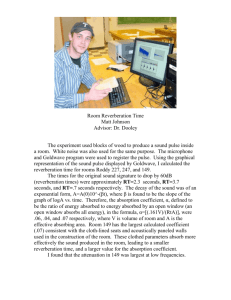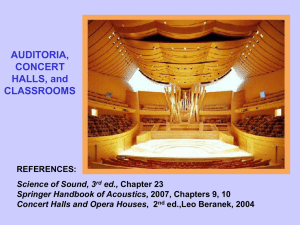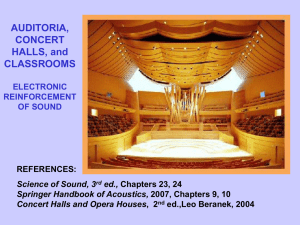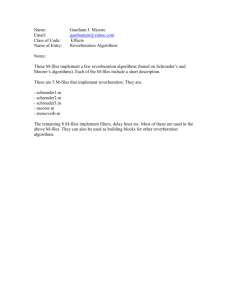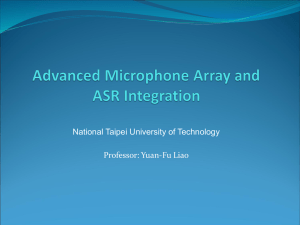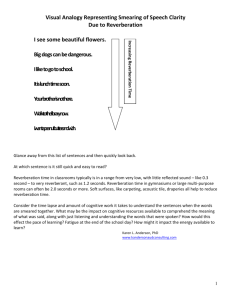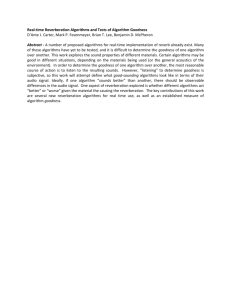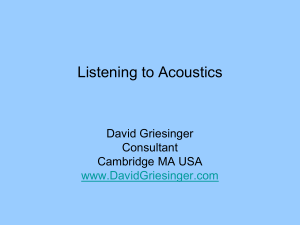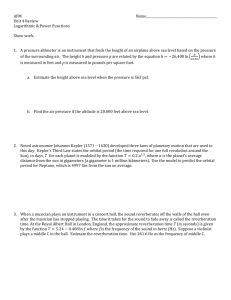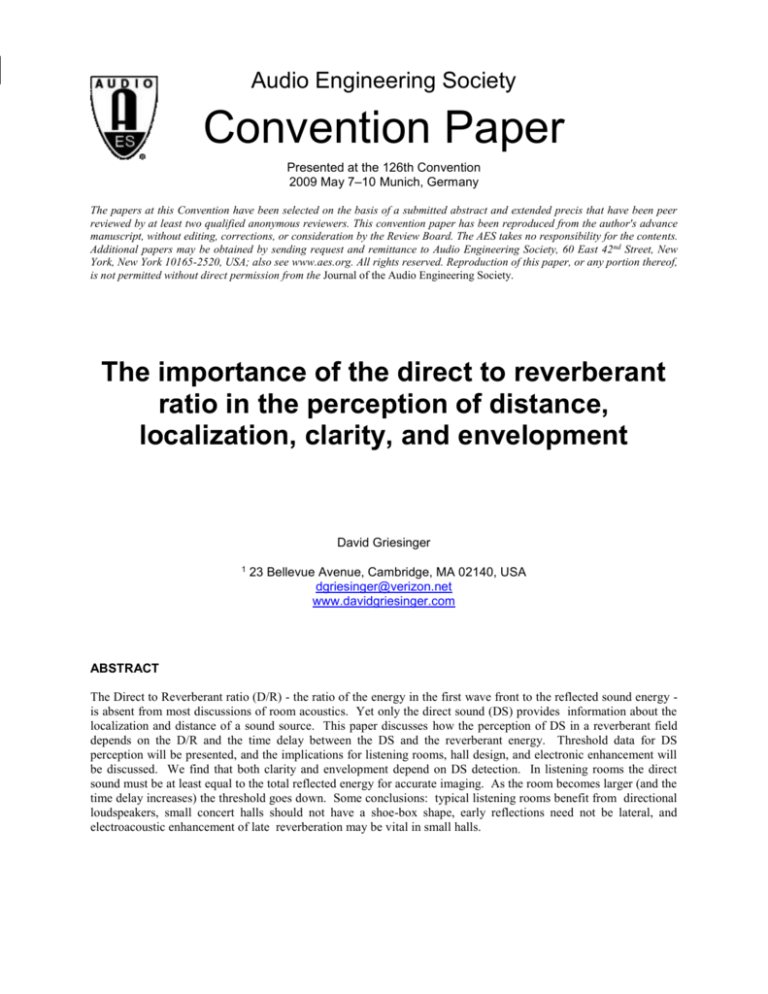
Audio Engineering Society
Convention Paper
Presented at the 126th Convention
2009 May 7–10 Munich, Germany
The papers at this Convention have been selected on the basis of a submitted abstract and extended precis that have been peer
reviewed by at least two qualified anonymous reviewers. This convention paper has been reproduced from the author's advance
manuscript, without editing, corrections, or consideration by the Review Board. The AES takes no responsibility for the contents.
Additional papers may be obtained by sending request and remittance to Audio Engineering Society, 60 East 42 nd Street, New
York, New York 10165-2520, USA; also see www.aes.org. All rights reserved. Reproduction of this paper, or any portion thereof,
is not permitted without direct permission from the Journal of the Audio Engineering Society.
The importance of the direct to reverberant
ratio in the perception of distance,
localization, clarity, and envelopment
David Griesinger
1
23 Bellevue Avenue, Cambridge, MA 02140, USA
dgriesinger@verizon.net
www.davidgriesinger.com
ABSTRACT
The Direct to Reverberant ratio (D/R) - the ratio of the energy in the first wave front to the reflected sound energy is absent from most discussions of room acoustics. Yet only the direct sound (DS) provides information about the
localization and distance of a sound source. This paper discusses how the perception of DS in a reverberant field
depends on the D/R and the time delay between the DS and the reverberant energy. Threshold data for DS
perception will be presented, and the implications for listening rooms, hall design, and electronic enhancement will
be discussed. We find that both clarity and envelopment depend on DS detection. In listening rooms the direct
sound must be at least equal to the total reflected energy for accurate imaging. As the room becomes larger (and the
time delay increases) the threshold goes down. Some conclusions: typical listening rooms benefit from directional
loudspeakers, small concert halls should not have a shoe-box shape, early reflections need not be lateral, and
electroacoustic enhancement of late reverberation may be vital in small halls.
Griesinger
1.
<Direct to Reverberant Ratio in Concert Halls>
INTRODUCTION
The work of pioneers such as Michael Barron greatly
influenced by research into spatial acoustics. Barron
studied the perceptual effects of adding (lateral)
reflections to the direct sound from a loudspeaker.
Fascinated by this work, I researched how our
physiology decodes the properties of a spatial sound
field, how we determine the loudness of the reverberant
component of a sound field, and the effects of different
combinations of early and late reflections on recorded
sound. [1] [2] [3]
For example, when we record a sound source with a
closely spaced microphone it is perceived on playback
as uncomfortably close to the listener. We found that
(lateral) reflections in the time range of 10 to 50ms can
contribute a sense of distance to the sound image,
pushing it away from the listener and behind the
loudspeakers. Such reflections additionally generate a
room impression front of the listener – as if we were
perceiving a room through an open window. A major
contribution was the discovery that it is the total energy
of the reflections that produces the effect. Each
reflection might be individually inaudible, but together
be quite significant.
Reflections later than 50ms create a “spaciousness”
impression that surrounds the listener.
The
effectiveness of these reflections in producing the
surround impression increases as the delay increases, up
to about 160ms. If there are a collection of reflections
of approximately equal level between 50 and 160ms a
strong enveloping reverberance is perceived, with no
sense of echo.
Michael Barron found much the same result using single
reflections, as shown in the well known drawing in
Figure 1. Note the vertical axis is the ratio of reflection
to direct (R/D). This paper will concern itself with the
inverse: the direct to reverberant ratio (D/R). The
vertical axis of Barron’s diagram covers the D/R range
of +20dB to 0dB.
Barron’s and our research has been both interesting and
useful in understanding sound recording and
reproduction. Recording engineers often start with a
collection of tracks that are essentially free of
reverberation. They mix these tracks together and then
add (naturally or artificially generated) reflections and
reverberation to create a natural sounding final product.
Figure 1 The subjective effects with music of a single
side reflection as a function of reflection level and delay
relative to the direct sound (azimuth angle 40 degrees).
From Barron. [4]
Barron’s and our research has been both interesting and
useful in understanding sound recording and
reproduction. Recording engineers often start with a
collection of tracks that are essentially free of
reverberation. They mix these tracks together and then
add (naturally or artificially generated) reflections and
reverberation to them to create a natural sounding
product.
Note that the vertical scale in Barron’s diagram goes
from a ratio of reflected energy to direct (R/D) of -25dB
to +5dB. The D/R ratio is thus -5dB to plus 25dB. This
range is appropriate for recorded music. We have found
that for nearly all recorded music – classical or popular
– the D/R is never less than +4dB. Thus the direct
energy – the first wave front – always has at least twice
the sound power as the sum of all reflected sound.
Given a choice of how to set both the early reflection
level and the reverberation level, both sound engineers –
and even the acousticians I managed to test (Beranek for
example) choose a direct to reflected energy ratio (D/R)
between plus 4dB and plus 6dB. The “curve of equal
spatial impression” in Barron’s figure is drawn at this
level.
But Barron was not interested in recorded sound. He
was trying to understand concert halls. Very few seats
in a hall have a D/R in this range. In a typical shoebox
hall the critical distance (the distance where the direct
sound and the reflected sound are equal) is 7 meters or
AES 126th Convention, Munich, Germany, 2009 May 7–10
Page 2 of 13
Griesinger
<Direct to Reverberant Ratio in Concert Halls>
less. All seats beyond this distance from a source will
have a D/R less than one. In fact, in many halls at least
half the seats have a D/R of minus 8dB or less.
This paper presents results of experiments that probe the
case where the direct sound is typical of real halls. A
primary tool uses simple image source models of halls.
The models compute a binaural signal corresponding to
the sound of a single instrument at a particular seat. The
HRTF functions used are my own, measured at the
eardrum. They are reproduced through headphones also
calibrated at the eardrum, which eliminates the most
common errors in binaural modeling. [5] The direct
component of the impulse response is extracted, and
both it and the later reverberation are convolved with
music. The d/r of the composite signal can be varied
experimentally, and a subject can report on how the
spaciousness and the localizability of the source varies.
Many alterations of the reverberant signal are possible.
For example, specific reflections can be amplified or
attenuated, the directional properties can be eliminated
or swapped over particular time ranges, etc. The results
have important implications for hall design.
2.
EXPERIENCES
This paper is largely about the perception of distance
between a performance and an audience member. There
is little mention of this perception in music acoustic
literature, yet I believe it to be critical both for drama
and music. A few personal experiences may be helpful
in explaining why it is so important.
Perhaps the first of these was during the installation of
the reverberation enhancement system in the
Deutchestaatsoper in Berlin. Barenboim had decided to
present Wagner’s Ring cycle in the Staatsoper, for the
first time since WWII. But he was not happy with the
acoustic. The Staatsoper has a natural reverberation
time at 1000Hz of 0.9 seconds, and Barenboim wanted
something closer to Bayreuth, 1.7seconds. Albrecht
Krieger had heard my demonstration at the Schaubuhne
Berlin during the AES convention, and suggested to
Barenboim that we try the system in the Staatsoper. As
a result, Krieger and I installed a shoestring system
before the opening of Rhenigold, and I adjusted it till I
liked it with my own singing. Krieger was delighted.
But Barenboim was NOT delighted. Horrible, he said.
Good on the orchestra, horrible on the singers. He gave
me 20 minutes to get it right – and I did. I installed a
shelving filter in the microphone inputs, which reduced
the reverberant level – not the reverberation time – by
6dB above 500Hz. Barenboim was delighted. Don’t
ever change it, he said, and jumped back into the pit.
The sound was indeed wonderful, and remains so to this
day. The clarity of the singers is almost unaffected by
the reverberation enhancement, while their fundamental
tones are rich. Most singers like the effect, although
one singer I met claimed that the hall remains as dry as
ever. I think he never heard the hall with the system off.
This is distinctly not my impression as a singer. I find
the enhancement is very audible, and quite helpful.
Barenboim was right (as usual). The sound in the
audience is glorious. The orchestra is full and rich (the
RT below 500Hz is 1.7 seconds), while the singers are
clear. It took two years for anyone to realize there were
electronics in the hall. All the improvement was
attributed to Barenboim’s skill as a music director –
perhaps rightly so. There is enormous dramatic
intensity. Aurally you are not at some comfortable
distance observing the scene – you are in it. The singers
seem to be singing or talking directly to you.
The few times the system has needed adjustment (some
of the old East German equipment was due for
retirement long before) Barenboim has heard the
problem immediately from the pit, and has urgently
demanded repair.
When we installed system in the Amsterdam
Musiktheater, I was able to spend a lot of time with
Peter Lockwood, the assistant conductor. He sat with
me in a variety of seats while listening to rehearsals.
We carried a remote control that allowed us to vary the
D/R in half-dB steps. We lowered the D/R gradually,
and the sound took on definite richness and depth. (The
same reverberant level shelving filter used in Berlin was
employed.) But a one point Peter said STOP – that’s
too much! I could not hear the difference. Listen, he
said. With that one extra half-dB the singer moved back
10 feet! So I listened – and for the first time I
appreciated the critical effect reverberation has on the
apparent distance of an actor. When the reverberation is
below some threshold the singers are perceived as close
to the listener – dramatically they occupy the same
space. Just a tiny bit more and they leave the space of
the listener, and occupy a different space far away.
Peter wanted the dramatic connection – and do did
Haenchen, the music director.
AES 126th Convention, Munich, Germany, 2009 May 7–10
Page 3 of 13
Griesinger
<Direct to Reverberant Ratio in Concert Halls>
Haenchen was responsible for my being in the
Musiektheater. He had recently come from the position
of music director at the Semperoper Dresden, which is a
small opera with an RT occupied of at least 1.5 seconds.
The Musiektheater is a larger space, with a RT below
1.3s at 1000Hz. Haenchen wanted me to reproduce the
sound of the Semperoper in Amsterdam.
As it
happened, I had visited the Semperoper some years
before and had binaural recordings of how it sounds. It
is small and quite reverberant. The orchestra is loud,
the singers are often overpowered, and often
unintelligible. I could plausibly reproduce this acoustic
in Amsterdam. Haenchen did not like it at all. I am
convinced he was not responding to artifacts in the
system, but to the lack of articulation in the singers.
“Turn it off!” is all he could say. It is interesting – and
the topic of another paper – how human perception can
adapt to a particular acoustic and think it wonderful.
But when there is the opportunity to change the acoustic
rapidly in an A/B comparison, very different
preferences are expressed.
But Hanenchen was very happy with Peter’s final
adjustment. When the opera directors I have worked
with are given the chance to choose immediately
between orchestral richness and dramatic intensity they
choose dramatic intensity. When this choice does not
exist, they LOVE the sound of the orchestra, and the
singers be damned.
After a similar experience with Michael Schonewand in
the old Royal Theater in Copenhagen, I was asked to
install a system in a shoe-box shaped drama theater in a
building next to the Royal Theater. The object of the
system was to improve the intelligibility of actors
during a conventional (speech) drama.
We had
previously installed 64 Genelec 1029 loudspeakers
around the audience, and a pair of Gefeil line-array
microphones at the balcony fronts.
Alas, the
microphones were well beyond the critical distance, and
it was not possible to pick up the direct sound from the
actors cleanly. I designed a fast acting gate that opened
at the beginning of every syllable, and promptly closed
just after the syllable ended. This signal was routed
with complicated varying delays to the loudspeakers,
and the system worked.
Both loudness and
intelligibility were improved.
A test was arranged. Five of the principle drama
directors in Copenhagen were invited to listen in various
seats to a live performance of “Uncle Vanya” in Danish,
with a full paying audience. The system was turned on
and off every 10 minutes, with no audience complaint.
At the end of the performance we all got together. The
directors were unanimous. “The system works, we
don’t like it, turn it off.” Why? The directors were not
sure. Finally a reason emerged. The system made the
actors louder, and more intelligible, but they sounded
further away. The value of D/R had been pushed too
low by the system, and the actors disappeared into a
different space. “I would rather the audience did not
understand the words than to lose the dramatic
connection between the actor and the listener” said one
of them. “If the audience can’t hear the words they
have to concentrate harder – which is just what I want.”
But all the directors agreed that they had to train the
actors better. The older actors were always intelligible.
Some aspect of training had been neglected. When I
related this to Schonewand, who had just conducted
“Tristan”, he was most amused, and not surprised.
“These young actors don’t know how to speak Danish!”
he said.
All these experiences have in common the critical
relationship between D/R and audience involvement.
At the IOA conference in Oslo, Krokstad (the Leo
Beranek of Norway) gave a wonderful lecture, where he
insisted that what we as acousticians (or sound
engineers) were seeking was involvement, not
envelopment. His final slide was of the Theatre de
Colon in Buenos Aires. ‘Is this the concert hall of the
future’ he asked? Our experiences in the new Oslo
opera indicate that he is probably right. The Theatre de
Colon is a large opera house with a high ceiling. RT is
about 1.6 seconds, the audience sits close to the
orchestra, the direct sound is audible in every seat, and
there is plenty of reverberation.
3. MAIN POINTS
3.1 The ability to hear the Direct Sound – the
sound energy that travels to the listener
without reflecting – is a vital component of the
sound quality in a great hall.
The direct sound – some call it the first wavefront –
provides the human brain with the only accurate
information about the direction (elevation and azimuth)
of the sound source. Where there is sufficient direct
sound energy, and sufficient time between the direct
sound and the reverberation that the brain can separately
perceive the direct sound, both intelligibility and the
sense of connection to the sound source are optimized.
AES 126th Convention, Munich, Germany, 2009 May 7–10
Page 4 of 13
Griesinger
<Direct to Reverberant Ratio in Concert Halls>
As we will see, the ability to separately perceive the
direct sound depends on time.
Providing the
reverberation from a previous sound has sufficiently
decayed, the onset of a new sound is always
uncorrupted by reflections. But the brain may not be
able to separate this onset from the high level of
reverberation that follows if the time delay is too short,
or if the sound has too gradual a rise-time. If we want
to optimize audience involvement as Krokstad insists,
we need to make the direct sound separately
perceivable.
3.2. Current acoustic measures neglect the
audibility of direct sound and audience
involvement.
Measures such as C80 lump the direct sound together
with a great many early reflections, particularly in small
halls. These halls can have what look like good clarity
values, but localization and sonic distance can be poor.
The current IEC definition of EDT ignores the direct
sound, unlike the original definition by Jordan. (And
the value obtained depends on the sample rate.) This is
why EDT and RT are almost always the same.
Calculations of acoustic parameters based on a
Schroeder integral obscure the actual D/R, since they
assume an infinitely long excitation. Musical notes are
seldom infinitely long. Short notes excite the hall less,
which increases the D/R and increases the effective
critical distance.
We need much better ways of measuring the direct
sound and its relationship to later reverberation. Two
such measures will be demonstrated here.
3.3. Hall shape does not scale
Our ability to perceive the direct sound depends on its
level compared to reflected sound, and on the time-gap
between the two. Both the direct to reverberant ratio
(D/R) and the time-gap change as the hall size scales –
but human hearing (and the properties of music) do not
change. A hall shape that provides great sound to a high
percentage of 2000 seats may produce a much lower
percentage of great seats if it is scaled to a capacity of
1000. Smaller venues produce a shorter delay between
the direct sound and the later reverberation. If audience
involvement is to be preserved we must: a) specify a
shorter reverberation time b) bring the audience closer
to the musicians, c) increase the time delay by absorbing
or directing first order reflections back to the source,
and/or d) increasing the directivity of the musicians by
adding absorption (not diffusion) to the stage.
If we demand a longer reverberation time, we must
design the hall so the longer reverberation time does not
result in a higher reverberation level, as conventional
theory says it must. This seemingly impossible trick
can in fact be done, both electronically and with
(expensive) architecture. (For example, the new Oslo
opera house is very well liked as a symphony hall.).
3.4.
Small halls have
reflections, not too few.
too
many
early
Although acousticians generally believe clarity can be
improved in small halls by adding early reflections, the
opposite is often the case. Small halls suffer from too
high a reverberant level, and a too rapid a build-up of
reverberation. Both problems can be alleviated by
selectively absorbing or reflecting the earliest arrivals
away from the audience – which frequently means
absorbing the first lateral reflections. This delays the
onset of reverberation long enough to allow the brain to
detect the direct sound. Contrary to the current
understanding of Barron’s results, the direction of early
reflections is NOT audible if the energy of later
reflections is dominant.
3.5. The build-up of reflected energy in a hall is
at least as important as the way the energy
decays – as we will see in the next section.
4. REVERBERATION BUILD-UP
The most important parameter that a sound engineer
adjusts when adding reverberation to a music mix is the
level – the loudness – of the reverberation. This control
is equivalent to adjusting the D/R in a hall. Changing
the D/R by one or two dB has a far greater effect on the
sound than changing the reverberation time by 30
percent or more.
But sound engineers know that the pre-delay control,
the one that changes the delay before the onset of
reverberation is also very important to the sound. As
the pre-delay increases the effective loudness of the
reverberation increases, allowing the engineer to
increase the D/R while preserving the spaciousness.
The clarity of the recording increases. Too much predelay and the reverberation is perceived as an echo –
AES 126th Convention, Munich, Germany, 2009 May 7–10
Page 5 of 13
Griesinger
<Direct to Reverberant Ratio in Concert Halls>
this is clearly undesirable. For this reason some
reverberation devices include a method of stretching out
a series of early reflections to fill the empty time
between the direct sound and the bulk of the
reverberation. (At Lexicon we called these controls
“shape” and “spread”.) Surprisingly, both D/R and
reverberant level have been routinely ignored in hall
acoustics.
Two years ago I was asked to write a review article for
the IEEE on hall acoustics. The article was supposed to
present a mathematical theory of halls that would
explain why they sounded the way they do.
Conventional theory – Morse and Beranek – could not
explain the obvious differences in sound between even
the best halls, such as Boston Symphony Hall (BSH),
and the Amsterdam Concertgebouw (CB). A simple
binaural model of these halls showed clear differences
in sound even when the RT was adjusted to be identical.
I decided to look carefully at the way sound builds
up.
direct sound is exceeded, very little changes as the D/R
increases further. The loudness is almost entirely
provided by the reflected energy.
Figure 3 Solid line: build up and decay of
reverberation in the Concertgebouw at 60 feet from the
stage. The excitation is a note 100ms long. The dashed
curve is the theoretical build up of energy from an
infinitely long excitation of the same amplitude. Note
the ~35ms time delay before the amplitude of the
reverberation exceeds the amplitude of the direct sound.
Figures two and three show a very clear difference in
pre-delay between the two halls. Boston has the shorter
pre-delay, and is perceived as less reverberant, and less
spacious, at least to the author. The Concertgebouw is
more reverberant and spacious, with a marvelous clarity
about the direct sound. But with some instruments,
such as solo piano, there can occasionally be disturbing
echoes.
Figure 2 Solid line: the build up and decay of
reverberation in Boston Symphony hall at a position 70
feet from the stage. The excitation is a note 100ms
long. The dashed curve is the theoretical build up of
energy from an infinitely long excitation of the same
amplitude. Note the ~23ms time delay before the
amplitude of the reverberation exceeds the amplitude of
the direct sound.
Note that the direct sound plays a vital role in these two
halls. Without the direct sound there is no pre-delay,
and they sound identical. If we measure the threshold
for the detection of direct sound in the two halls we find
a lower threshold in the Concertgebouw, implying that
there are more seats with good localization and clarity.
BSH is a wonderful hall.
There is clarity and
localization over a wide range of seats. From about row
10 to row 30 the sound is nearly identical and very
good. It degrades slowly further back. The sound is
identical because once the threshold for the detection of
Threshold data is given later in this paper that predicts
that the direct sound will be separately perceived in
BSH and CB over a wide range of seats. In fact, in
experiments with these models there is a distinct clarity
and lack of muddiness in the sound for at least 2/3 of the
4.1. Consequences for BSH and CB
AES 126th Convention, Munich, Germany, 2009 May 7–10
Page 6 of 13
Griesinger
<Direct to Reverberant Ratio in Concert Halls>
seats in BSH and 3/4 of the seats in CB. But the halls
are better than this in practice.
throughout the hall would also be the same. Is this what
happens?
In the models we assumed the source was
omnidirectional. This is usually not the case. The
human voice is has a directivity of at least 2dB above
1000Hz, and the same is true of solo violin and many
other instruments. Many more seats are likely to be
good, at least for soloists.
The models show something else: once the threshold of
direct sound detection is exceeded there is very little
change in the sound quality until the direct sound and
the reverberation are within 3dB. The clarity is
determined by the detection of the direct sound. Once
this is achieved, increasing the D/R makes little
difference. The loudness of the sound is almost entirely
due to the reverberation, so both clarity and loudness are
constant over a wide area.
This consistency of sound quality is aided by several
other factors beyond the scope of this paper. In brief,
rectangular coffers in the walls and ceilings reflect
frequencies above 1000Hz back to the orchestra, where
they are absorbed. This creates a frequency dependent
filter for the reverberant level, just as the filter we used
for Barenboim in the Staatsoper. In addition, there is
evidence that the strength of the reverberation is lower
than predicted in the back of these halls, particularly
near the floor. These factors will be explored in future
papers.
Figure 4 Build up and decay in a hall half the size of
BSH. The RT decreases to about 1.1s, from a value of
2.2s in the full size BSH model. Note as expected the
onset time delay has also decreased a factor of two. But
notice the D/R has decreased, from about minus 6dB to
minus 8.5dB. In spite of the far lower RT, these
changes cause a significant reduction in clarity and an
increase in perceived distance to the source. An
audience member can compensate by buying a more
expensive seat – but the number of good seats decreases
considerably.
4.2. Consequences for halls under 1500 seats
A pervasive assumption among acousticians is that the
best possible shape for a hall of any size is a shoebox,
and the reverberation time should be two seconds, plus
or minus 0.2s. This assumption is wholly without
evidence.
What happens if we build a shoebox hall with half the
dimensions of BSH? (This is a very popular idea).
Instead of 2700 people, the new hall will hold about
700. What happens to the build-up and decay? Let’s
assume we do not change the design of the hall – so the
reverberation time will be half. Let’s also keep the
source and receiver position exactly the same, except
scaled. In this case the only variable that should change
is time. RT should go down a factor of two, as should
the critical distance. We would expect the D/R at our
chosen seat to remain the same – and the average D/R
Figure 5 A similar diagram for an existing small
shoebox hall, of about 350 seats. The measured RT is
1.0s. The D/R has is -10dB, and the onset delay is
smaller than figure 4. This hall is reasonably articulate
AES 126th Convention, Munich, Germany, 2009 May 7–10
Page 7 of 13
Griesinger
<Direct to Reverberant Ratio in Concert Halls>
in the middle seats on the floor. Closer to the stage the
sound is loud and harsh. Further back the sound is
blurred, with poor separation between notes and
instruments.
Figures 4, and 5 show the folly of assuming that
because a shoebox shape works well (sometimes) for a
large hall, the shape is ideal for a smaller hall. Unlike
our expectation, the D/R has decreased, even though the
RT has decreased. Removing all possible absorption to
bring the RT back up to 2 seconds will further decrease
the D/R and make the situation worse. The D/R
decreases because sound builds up quicker in a small
hall, so a note of a certain length creates a stronger
reverberation. The hall has become smaller by some
factor, but the tempo of the music remained the same.
The heads of the listeners did not get smaller, and their
brains did not work faster either.
there is a lot of extra volume on top, nearly every seat
combines excellent clarity and localization with a
beautiful sense of surrounding reverberation. While
ideal for chamber music, small orchestras also sound
wonderful. The hall is small but similar to the Theatre
de Colon. It fulfills Krokstad’s ideal – it maximizes
audience involvement.
5. THRESHOLD DATA
Thresholds for the onset of localization were measured
using a binaural hall model and a source signal that
emulated a cello, playing notes of a scale with a risetime of 20ms, a fall time of 100ms, a duration of 200ms,
and a gap between notes of 100 or 200ms.
Alas, the folly is entrenched. A great many small
shoebox halls are being built. The good news is that
some of them sound better than one would expect from
these models. The best drastically increase the cubic
volume per seat – becoming essentially a large hall with
a small number of seats. When the extra volume is
above the listeners, the sound can be pretty good. While
I was in Helsinki I visited a ~400 seat small hall. The
hall was large and high for the number of seats it
contained. The RT was ~ 2.0 seconds, as specified by
the client – but in spite of this many of the seats
sounded at least OK. The best sound was in row 4. In
row 8 it was barely OK. In row 11 it was muddy and
blurred – and in row 13 (there were 14 rows) it was
good again. Eckhard Kahle and I independently agreed
on these assessments, which were confirmed by binaural
recordings. ( Most likely the sound gets better further
back because there is less reflected energy coming from
the rear. ) In the violin-piano concert I heard the two
musicians played as close as possible to the audience, so
the large reflecting stage area had little effect. A
concert involving larger forces would likely dissolve
into mush.
4.3. Good small halls exist
One of the best small concert halls is in Boston: Jordan
Hall of the New England Conservatory, 1200 seats, built
in about 1910. This hall is half of an octagon in shape,
with a very high ceiling. The audience surrounds the
stage, on the floor and in a single balcony. The RT is
about 1.3s occupied. Because the audience is closer to
the stage than they would be in a shoebox, and because
Figure 6 Top – thresholds for the detection of
localization as a function of the time delay between the
direct sound and the build up of reverberation to an
energy equal to the direct sound, and as a function of the
D/R. Note the threshold decreases as the delay
AES 126th Convention, Munich, Germany, 2009 May 7–10
Page 8 of 13
Griesinger
<Direct to Reverberant Ratio in Concert Halls>
increases. Bottom – when the gap between notes
decreases, the threshold increases.
Figure 6 shows some thresholds for localization of a
cello tone. The threshold is the lowest for the 1000Hz
band, and is very high for the 250Hz band. This shows
the importance of maintaining a high D/R above
1000Hz in a good hall. How can this be done,
particularly if a client has specified a constant reverb
time of 2 seconds? The trick is to reduce the
reverberant level at these frequencies by clever use of
frequency dependent reflections and diffusion. If
frequencies above 1000Hz can be preferentially
reflected back to the front of the hall where the direct
sound is strong and absorption is high, the D/R in
distant seats will be raised. This is the magic provided
by coffered ceiling and wall surfaces in Boston, Vienna,
and Amsterdam.
In the experiments described in section 7 of this paper
we found that to obtain thresholds that matched
subjectively the localizability of a string quartet we
needed to reduce the gap length to 50ms. These
thresholds will be published in a future paper.
reverberation. Remember it takes time for reverberation
to develop. A click is short enough that very little
reverberant energy is generated, and the reverberant
level is low.
But musical notes are usually not that short, and they
tend to mask one another.
The perception of
localization relies on very brief inputs of real
information. Typically only the onsets of sounds can be
localized, and only if they have not been masked by
previous sounds. So a measure based on the percentage
of localized onsets makes sense.
My system for measuring localization has been
previously described. [7] We find the IACC in
overlapping 10ms segments of a musical signal, and
plot 1/(1-IACC) in 1/3 octave bands. The result is a
map of the D/R of the onsets of sounds as a function of
time and frequency. The percentage of time these are
over some threshold can be counted. We can also plot
the Azimuth determined by this measure as a function
of azimuth and frequency. This shows how consistent
the azimuth is over frequency – also a measure of hall
quality.
6. BINAURAL MEASURES
The clarity of halls and stages changes dramatically
when they are empty, and they are hard to measure
when they are occupied. I believe this difficulty has
contributed to the neglect of direct sound in the current
literature. We need measures that analyze the same
signals we do – music and speech – recorded with
microphones with our natural hearing. The author uses
binaural recordings made at his eardrums for the raw
data.
Ideally a measure for distance and clarity should use the
same mechanisms that the human brain uses to
determine these perceptions, including a neural model. I
have worked on two such measures, one for
localization, and one for distance. Both measures take
as inputs binaural recordings of a small number of
instruments – ideally a solo instrument, actor, or singer.
The recording is analyzed with a hearing model and
azimuth and distance information is extracted. The
percentage of time where such an extraction is possible
becomes a measure of the space.
It is almost always possible to localize some sounds in
an acoustic space. The brain is good at separating the
direct component of a sharp click from the
Figure 7: the number of times per second a note from a
solo violin is localized in row 4 of the small hall near
Helsinki. The indicated azimuth is correct – about 10
degrees to the left of center. The binaural recording was
made with probe microphones at the ear drums of the
author, and plays with startling realism with headphones
calibrated the same way. A ~ 5 second segment was
analyzed to make the graph.
AES 126th Convention, Munich, Germany, 2009 May 7–10
Page 9 of 13
Griesinger
<Direct to Reverberant Ratio in Concert Halls>
Figure 8 A surface showing the frequencies of
maximum localization for the violin in figure 6. The
major peak is for the 1000Hz 1/3 octave band.
Figure 9 A time/frequency surface showing the peak in
running IACC that occurs at the onset of each note of
the violin in Figure 6. For a very short time the
localization is quite clear.
Figure 10 Number of localizations per second for the
same violin in row 11 of the small hall in Helsinki.
Note the small number of localizations, and the poor
consistency of azimuth. Localization is very difficult,
but sometimes possible, in this seat. The sound is
muddy.
We can build a similar measure for distance, in this case
using the concept of harmonic coherence. [6] Harmonic
coherence is a monaural measure, which tests the degree
to which harmonics of a pitched sound source are
phase-locked to each other. This phase locking is
highly audible, resulting in a sound described by
Zwicker as “roughness”.
The phase locking is
destroyed by reverberation, and can be used as a
measure. When the phases are locked the fundamental
frequency is easily determined by rectifying critical
bands. For these examples I plot the strength and
frequency of the extracted fundamental as a function of
time. All critical bands with significant fundamental are
combined. Here I show sounds from opera singers
binaurally recorded in Oslo.
AES 126th Convention, Munich, Germany, 2009 May 7–10
Page 10 of 13
Griesinger
<Direct to Reverberant Ratio in Concert Halls>
Figure 11 A strong baritone forcefully singing directly
to the third balcony. The sound there is often muddy,
but the fundamental pitch of this singer came through at
the beginning of two notes. He seemed to be speaking
directly to me, and I liked it.
Figure 13 An existing small hall. Seating capacity
about 350 with a single balcony. RT occupied 1.0s at
1000Hz. Note the highly reflective stage, floor and
ceiling elements. Sound in the first few rows was loud
and harsh, sound in the rear half of the hall was nonlocalizable and muddy.
Many acoustic improvements had been proposed over
years. All of them involved removing absorption from
the hall and/or installing additional reflectors on stage.
The data in this paper suggests something quite
different. If we absorb as many first-order reflections as
possible we can increase the D/R, and at the same time
we can increase the time delay between the direct sound
and the build-up of reverberation. Everyone involved
(except Steve Barbar) was skeptical, to say the least.
Figure 12 The king (in Verdi’s Don Carlos) on the
other hand, in his wonderful solo aria, was not able to
reach the third balcony with the same strength. The
fundamental pitches are not well defined. He seemed
muddy and far away. The pathos was muted.
7.
A REAL-LIFE EXAMPLE
Through the generosity of the Longy School of Music in
Cambridge, the help of Steve Barbar of Lares
Associates, and the firm Acentech, I was able to
perform a week-long experiment in the small hall shown
in figure 5 and 13.
But we added about 700 ft^2 of absorption to the stage,
effectively increasing the directivity of the musicians by
about 2dB. In addition we added some absorptive
panels to the side walls to decrease the strength of the
first-order lateral reflections above 1000Hz. These
modifications could be taken in or out in about 5
minutes, allowing (almost instant) A/B comparisons.
We also added a small LARES acoustic enhancement
system with 25 loudspeakers.
Many faculty and students played in the hall during the
experiments, and all the sounds were recorded with
three dummy heads, as Soundfield, and a close mike
array on the stage.
The sound was dramatically better. Far from being put
off by the absorption on stage, the students and faculty
at the school were delighted. Several were sure we had
AES 126th Convention, Munich, Germany, 2009 May 7–10
Page 11 of 13
Griesinger
<Direct to Reverberant Ratio in Concert Halls>
found a much better piano. The middle registers were
suddenly clear and better balanced. Soloists playing
together with the piano no longer had to force to be
heard, and the same was true for solo violin. The
difference to the audience was equally great. The
muddiness was gone. The sound was more articulate,
better balanced, and rich.
The LARES system was adjusted to a minimal value.
We simply used it to bring the occupied RT back to the
previous value of about 1.0 seconds at 1000Hz. More
was not needed. We also turned it off frequently to see
how the musicians reacted. They found the effect
subtle. Nearly all the improvement was due to the
absorption – and the absorption on stage was the most
effective. The result was amazing to most of the
listeners. The idea that adding absorption to a small hall
which already had an RT of 1 second or less could
improve the sound was unheard of. But the result was
clear to everyone. We also tried adding hard reflectors
behind the piano, creating a mini shell. The sound in
the audience was poorer.
The overall result was not unexpected to me. The
model work predicted it. But there was an easily
available example. In the same building as Jordan hall
is Williams Hall, a small recital hall of about 350 seats.
Williams is almost cubical, with about 1.3 times the
volume of the hall at Longy. The stage is old fashioned,
made fully absorptive with heavy drapery around the
back walls and above the proscenium. The sound for a
chamber group has been wonderful for nearly 100 years.
No one is thinking of changing it. But it seems to have
been forgotten by acousticians.
Figure 14 Williams Hall at New England Conservatory.
There are about 350 seats. Note the fully absorptive
stage, coffered ceiling, and the relatively close seating
of the audience.
8. ACKNOWLEDGEMENTS
The author wishes to thank Steve Barbar of LARES
Associates for his tremendous support of this project,
the Longy School of Music and their president Karen
Zorn for their encouragement and support, the essential
organizational help of my wife Harriet, and many
friends who pitched in to do the work.
7.
REFERENCES
[1] Gardner, William “Reverberation Level Matching
Experiments” Proceedings of the Wallace Clement
Sabine Centennial Symposium, Cambridge MA 5-7
June 1994. (a copy of this paper is on the author’s
website.)
[2] Griesinger, David “ The effective loudness of
running reverberation in halls and stages” – ibid. A
similar paper “How Loud is my Reverberation” is
on the author’s web page.
[3] Griesinger, David “The psychoacoustics of
apparent source width, spaciousness and
envelopment in performance spaces” Acta Acustica
Vol. 83 (1997) 721-731. ( this paper is on the the
author’s web page)
[4] Barron, Michael “Auditorium Acoustics
Architectural Design” E&FN SPON 1993
AES 126th Convention, Munich, Germany, 2009 May 7–10
Page 12 of 13
and
Griesinger
<Direct to Reverberant Ratio in Concert Halls>
[5] Griesinger, David “Frequency response adaptation
in binaural hearing” presented at the AES conference in
Munich, May 2009 A previous version of this talk is on
the author’s web page.
[6] Griesinger, David “Pitch Coherence as a Measure of
Apparent Distance and Sound Quality in Performance
Spaces” Presented at the IOA conference on Hall
acoustics, Copenhagen May 2006. This paper is on the
author’s web page.
[7] Griesinger, David “Lecture Slides from the RADIS
conference, Japan 2004.” A link to these slides and to
the audio examples can be found near the top of the
author’s web page.
AES 126th Convention, Munich, Germany, 2009 May 7–10
Page 13 of 13


